Congratulations! The search is finally over; you have found the perfect puppy for you and your family. But wait, have you prepared adequately for his arrival?
As a responsible pet lover, you ought to provide a safe environment for the newest member of your family. A puppy is more like a baby, only that it is more active, curious and destructive. Therefore, the process of puppy proofing your home should involve the removal of dangerous hazards both inside the house and in the garden.
What is Puppy Proofing and What does it Involve?
Although puppy proofing might seem apparent, it’s not. Even the most experienced puppy pet lovers forget a few crucial steps. Check out these descriptions of puppy proofing:
It is creating a suitable environment in which your puppy can flourish. Doing away with situations where the puppy needs correcting or telling off means that he will feel more loved and appreciated for doing good things. Puppies do well in positive environments.
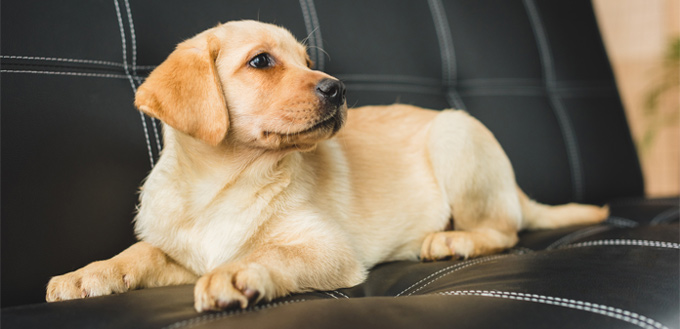
It is walking a mile in your puppy’s shoes and looking at your home and garden from their point of view. You should anticipate and prevent any probable hazardous situations from occurring.
It is guarding your home and possessions. Your puppy will view everything as a toy, yet some things are precious to you. You should protect your belongings from the puppy’s teeth and paws.
Puppy Proofing Basics
Remember that your puppy’s curiosity will lead him into playing and chewing anything they get their paws on. With this in mind, follow these simple puppy proofing tips in your yard and home.
- Never leave your puppy unsupervised
When you allow your dog to roam in the house, make sure you observe him. Alternatively, you can impound them in a small, secure room. You may opt for crate training your puppy to hold them temporarily when you are unable to supervise them.
You May Also Like: Dog Crates
- Keep dangerous and expensive items out of reach
If an item is too costly or dangerous for them to toy with, do not allow them to play with it. As long as the puppy finds the item interesting to play with, they will go ahead and may destroy it or harm themselves.
Related Post: Dog Toy Storage
- Buy chew toys
Ensure you have a good selection of chew toys at every location that the puppy spends time. Such items will keep the puppy occupied and help with the teething process. They also help in relieving stress and promote chewing of safe things rather than your belongings.
- Carry out an audit of all the plants in your compound
Some plants are poisonous to dogs. Make a list of all plants in your compound and check them off against the list of known toxic plants. Get rid of the ones that are unsafe.
- Use bitter-tasting sprays
To prevent the puppy from destroying your belongings, you can use bitter-tasting sprays on the items you wish to preserve. You can save things like table legs, corners of cabinets and skirting boards.
Related Post: Dog Chew Spray
- Invest in dog gates and barriers
They will restrict access to certain parts of your home. It is advisable to allow your puppy to access two rooms only until when they are responsible enough and trustworthy.
You May Also Like: Dog Playpens
- Lock up anything that is potentially poisonous
Keep things such as bleaches, household cleaners, antifreeze, mothballs, laundry detergents, insecticides, shampoos, and rat poisons in locked cabinets.
Look at Everything Through your Puppy’s Eyes
One of the best ways to puppy proof your home is to think like a puppy. Walk around the yard and in your house, looking at everything from a puppy’s point of view. Consider things that they can get their paws on, and analyze the result of playing with the item. If they can be harmed or damage the item, put it away. Walk through every room and survey every wall and fixture in it.
Are there any dangling cords? Can you spot any items lying on the ground? Can the puppy get into any drawers? Is there anything that can be pulled off from up high?
Some experts recommend that you get down on your fours, crawl around your house and put yourself in their shoes. Although it’s not necessary to take the exercise this far, it is an ideal way of ensuring you do a thorough check.
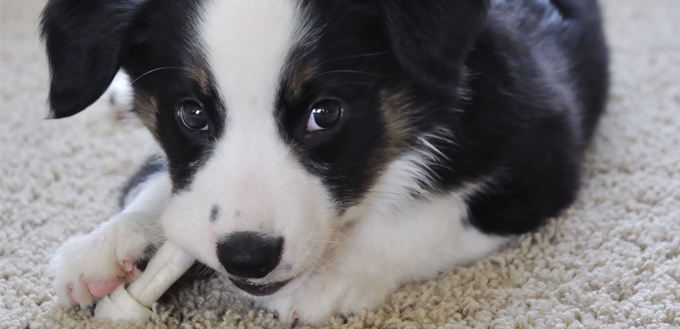
Tips to Puppy Proof inside the House
Here are some of the general things you should do when puppy proofing indoor spaces, where the pet will stay most of the time.
1. Replace the regular rubbish cans with dog proof trash cans
The latter are suitable because dogs cannot get inside them, so they won’t manage to eat the trash. Dogs are fond of eating junk, and in the process, they might swallow hazardous materials.
2. Remove and store out of reach all tiny objects that your puppy can swallow
These items include coins, small ornaments, mobile phones, paper clips, jewelry, tissues, and children’s toys. Everything must be kept out of reach. Such items are not only dangerous because they contain toxic material, but because it is easy for the puppy to swallow them; thus resulting in a blockage that requires medical intervention.
3. Do not leave any food lying around
Some human foods are toxic to dogs while others are merely unhealthy due to the high sugar and fat content. There is also a possibility that the puppy will choke on packaging material. Some of the potentially hazardous foods include tea, raisins, uncooked meat, small bones, onions, coffee grounds, and chocolate. To ensure safety, put all food away and feed your puppy using the right dog bowls for his age.
4. Clear the floor
Never leave items lying on the floor if you wouldn’t want the puppy to play with them. Puppies are unable to distinguish between your designer shoes and their chew toys.
5. Keep away any medication and supplements
Puppies enjoy getting into plastic bottles and containers. Human medicines and supplements are potentially fatal to your pet, so make sure they are out of reach.
6. Fix any hanging electrical wires
Only a few things are as much fun to chew to puppies as electrical wires. You should ensure that run cables are out of your puppy’s reach. Run the cables through PVC tubing or spray them using bitter chew deterrents. Remember to unplug electrical items when not in use.
7. Keep puppies in areas where the floor is easy to clean
Carpets and rugs can be destroyed by puppies especially if you are unavailable to supervise them. That is why you ought to keep your pet on tiled, linoleum or wooden flooring until they are trusted not to chew and are house trained.
8. Use child safety latches
Buy child safety latches and put them on cabinet doors, all drawers, and your freezer or fridge. These places hold toxic substances, and if the puppy accesses them, they might be potentially lethal. Puppies like exploring, so with time they will learn how to open the drawers and doors.
9. Keep heavy things away
Ensure that there aren’t any heavy things lying on the floor which your pet might fall on and be harmed. This means covering your tables and ensuring there are no protruding surfaces.
10. Get rid of toxic plants
Some plants are toxic to dogs. Therefore, make a list of all your plants and check for their toxicity. If they are toxic to dogs, get rid of them.
11. Tie hanging cords and strings
Any strings on curtains and blinds should be tied up. If a puppy sees a hanging thread, he will want to play with it; thus risking choking or strangulation.
12. Ensure that clothing and laundry is out of reach
Since worn out clothes carry your smell, they might appeal to your puppy. Cases of puppies that swallowed socks are common.
13. Treat furniture corners, the lower half of all doors and walls as well as skirting boards
Use a bitter tasting spray on these areas to prevent the puppies from damaging them.
14. Be cautious of folding sofas or doors that slam shut in the wind
Your puppy might crawl under sofa beds; thus, make sure he is not there before folding or opening it. As for doors that slam shut in the wind, they might hurt your puppy especially if the tail or leg gets shut on. Therefore, install self-closing door hinges where possible.
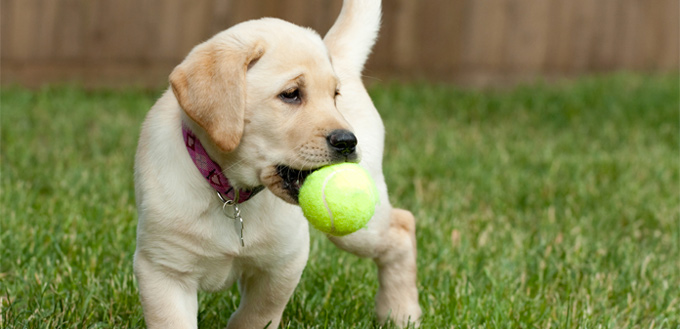
Tips to Puppy Proof outside in your Garden or Yard
Just as indoor puppy proofing is important, you should also ensure that your garden and yard do not contain things that the puppy can swallow or chew.
1. It’s not possible to make it 100% safe
For starters, you need to appreciate that it is not possible to make your garden or yard 100% puppy proof. If you want to get close to perfection, you either build a dog run or give them 100% supervision. The run is a small, fenced area that you can make safe by confining your puppy inside it.
2. Make high fences
Ensure that your barriers are high enough to keep the dog from getting over them. 6 foot is the suggested height for a Labrador.
3. Install self-closing hinges
Your puppy might attempt to escape your yard, so install self-closing hinges on the gates. This is because people tend to leave gates open, giving the puppy an easy escape.
4. Puppy-proof your fence
Walk along the fence line as you carefully note any broken parts that the puppy can squeeze through. Puppies can fit into smaller spaces than you can imagine, so don’t assume any opening, regardless of how tiny it might seem. Ensure the security of the perimeter by using extra panels or chicken wire where necessary.
You May Also Like: Ways to Dog Proof Your Fence
5. Make sure your fence has a flat top
Barriers which have spiky heads are dangerous to puppies since they might hang themselves on their puppy harness. So, get rid of the spikes, whether wooden or metallic. Remember to check your fence for any protruding wires, nails or screws that the puppy might run through.
6. Use pet safe pesticides, fertilizers and insecticides
Now that your puppy will be running around the garden, it will be difficult to control what it licks. That is why you should use chemicals that are labeled pet safe around the yard.
7. Keep pest control poisons out of reach
If you are using any toxins for pest control, you must ensure that the pet does not access the area until the poison dissipates.
8. Make sure that the gaps between your balcony and raised deck are not big
Puppies can easily slip through large holes, so make sure you install a chicken wire to block the gap entirely.
9. Fence the pond and swimming pool
Until your pet is mature or becomes a good swimmer, large water bodies must remain fenced for their safety. Water is potentially fatal to young puppies.
You May Also Like: Dog Pools
10. Fire pits, garden heater, and BBQs are potential risks due to heat and fire
Ensure that your puppy is away from these items when in use.
11. Keep away all garden tools
A playful puppy is likely to suffer harm when they get their paws on sharp garden tools.
12. Use dog proof trash cans
Trash contains toxic materials that can make your puppy unwell. That is why you should use trash cans which the puppies cannot enter.
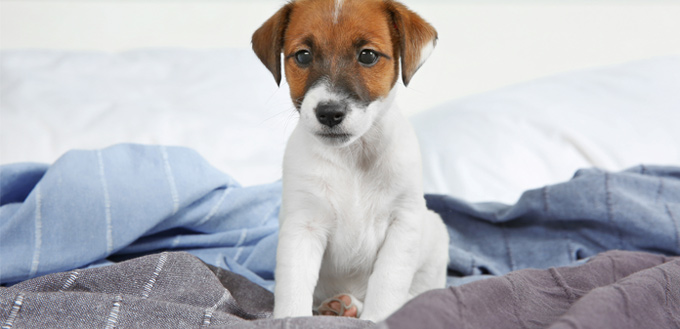
Puppy Proofing Checklist for Every Room
Now that you already know how to puppy proof your indoors and outdoors, here’s a step-by-step procedure of puppy proofing all rooms.
Your Key Living Areas
The primary concern here is to make the rooms free of clutter.
- Ensure that cords and wires are tied up safely.
- Keep away all newspapers, slippers, toys, remote controls, pictures, wallets, mobile phones, cushions, and other tiny gritty that might be within the vicinity.
- Cover all air conditioning vents that the puppy might fit into
- Ensure that small pets like hamsters and fish are out of reach
- Guard off heaters, fireplaces, and heaters to prevent the puppy from suffering burns
- Remove all poisonous houseplants
- If you use your living area as an office space, ensure you lock away all stationery like staples, erasers, drawing pins, staplers, rubber bands, and any other items that might harm your pet.
Bedroom Risks
If you allow the puppy into your bedroom, you should make it puppy proof. Ensure that items like lotions, aftershave, jewelry, creams, perfumes, coins, hair accessories, aftershave and other things that the puppy can swallow. It might seem like tiring, but it’s necessary. Ensure that your clothing and laundry are not left lying around. If you want to use the bedroom with the puppy, make sure you buy dog beds to be used when the puppy attains the appropriate age.
Be sure to check out our guide on beds for puppies.
The Kitchen
The primary concerns in the kitchen are foodstuffs, sharp objects, and heat sources. Remember to fix child latches on your cabinets, drawers and the fridge freezer. That way, the puppies will not access the drawers and cabinets, since they might contain harmful chemicals and sharp objects. Make sure you tie up any running cords. Keep the trash out of the kitchen or use dog proof kitchen trash can. Put all foods away. Even though the food doesn’t seem harmful, the packaging can be potentially dangerous. Take caution when it comes to hot food and hot fluid such as boiling water and oil.
The Bathroom
With all the chemicals, medications and lotions that are found in the bathroom, it is a potentially hazardous place for a puppy to visit, leave alone stay. Therefore, the first cause of action is to install a child latch on the bathroom door. Do not leave shampoos, soaps, tissues or any other item lying around the bathroom. Consider installing cabinets and locking these things there. Shorten any blind cords or chain pulls. Alternatively, you can tie them to avoid strangulation and choking risks.
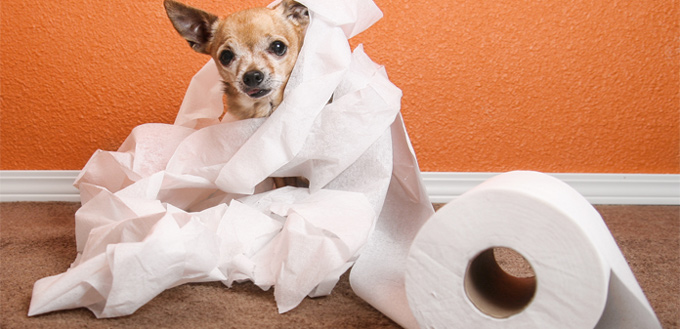
Ensure that the toilet lid stays down. This is because the puppies will want to drink the water once they climb on the cover. This is unhygienic. Avoid keeping your indoor dog potty in the bathroom, and instead, place it in the puppy’s kennel.
The Garage Should be Out of Bounds!
Considering that the garage is often used for storage of tools, chemicals, and other things, it is a potentially lethal place for your puppy. There is anti-freeze, insecticide, paint thinners, insecticides, rat poisons and motor oil; all of which are fatal to puppies. Then there is a selection of hazardous garden tools such as bolts, screws, nails and other hardware, which can cause immense harm if swallowed. Plant bulbs and stored seeds can be a choking hazard. Therefore, ensure that your garage remains locked up, and your puppy cannot access it.
Puppy proofing aims at protecting your puppy and your property. Puppies are mischievous so that they might get themselves in all kinds of trouble. By taking time to puppy proof your home; you will be giving your puppy the safest and best start in life.
The process might seem like too much time but remember it’s not for long. Once your dog matures, it will get over the experimental, chewy stage and learn how to behave well. After the pet proves that he is trustworthy, you will not have anything to worry about.
Sources:
- Dr. Katie Grzyb, Puppy-Proofing Checklist, PetMD
- Dr. Jason Nicholas, 10 Point Checklist for Puppy Proofing Your Home, Preventive Vet
- Puppy-proofing Your Home, PAWS






